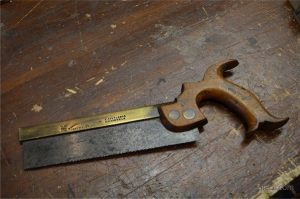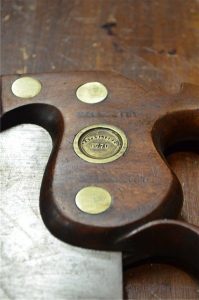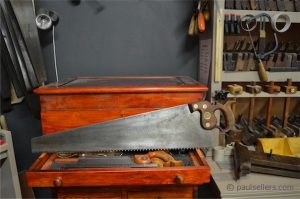Old saws
I don’t suppose a Bahco hardpoint saw will ever be restored. Certainly never resharpened. Plastic handles do disintegrate when left in the sun and so it’s hard to imagine why they would ever be restored.
I worked in the Castle today and caught up on some restorations on two saws I bought on eBay. One is quite rare, an 8″ Robert Groves I had wanted for some time, and a larger 26″ handsaw by the same maker.
The dovetail saw is really very nice despite a couple of emerging teeth and some uneven sections that undulate periodically. At 16PPI, the saw is resharpenable and this was the reason that this saw the most commonly available tooth size for small saws. In my view, the only disposable saw should be saws with finer teeth, because to sharpen finer saws becomes much less practicable and the steel is often too thin to sharpen with any degree of success. That’s where Zona model saws come into their own. They are not classic looking and most people might at first glance dismiss them as hobbyist level saws, but the cut metal and wood very effectively and are especially useful for ultra fine work. I keep a couple around for miniature work and superfine dovetails in 1/8″ thick stock and such.
This saw had a couple of emerging teeth and I corrected several spots of unevenness along the length of the saw teeth. This took one session of reshaping, one topping (jointing USA) and one further filing to actually sharpen and finally shape the teeth. It also needed some new set. After 20 minutes the saw became an addition to my user saw collection.





“Emerging teeth”? That’s a rather positive way to put it…
But since you’ll sharpen them repeatedly, I suppose the term is as precise as any other.
Perhaps I should have qualified this a little more. I do sharpen the emerging teeth back and front to centralise it in place along the whole, but barely. This gives them consistent shape as the other teeth are actually being reduced down into the saw plate. Usually it takes about 4-6 sharpenings for a broken tooth to emerge back into its rightful place in the whole.
I’m glad you posted about this – I have had no end of problems with saws from eBay and was wondering if you have any tips for getting them back in shape.
I’m fine with jointing and sharpening saws (I’ve watched your DVD on it) but the main issue I have is with the saw plate not being straight. This is causing the saw to veer from the cut line. I’ve read a few articles about correcting the problem using large and small hammers with convex heads, and striking the offending areas carefully and with the correct force so I’ll give this a try but I wanted to know if you’ve dealt with the problem and how you did.
George.
Hi Paul,
I first discovered you at Harrogate exhibition last year and was very interested in your positive approach to hand woodworking. It has been a while since I have done any woodworking but your book and website are very inspirational and I dont think it will be long before i have a project on the go! I would quite like to make one of your benches as featured in the book and video series.
I wanted to comment today because I too have the same little R.Groves & Son saw pictured above. I have collected a few old tenon/dovetail saws since last year but I lack a bit of confidence in what to do next with the saws in terms of sharpening – I dont want to ruin an antique saw. On my Groves saw there is bit of play where the brass back sits inside the handle. The saw wobbles slightly when you grip the handle and wave it side to side but I suppose it has seen a bit of work over the years. I will send you a photo of the saw when I get chance. Do you have a video on saw restoration/sharpening?
Thank you,
Matthew.